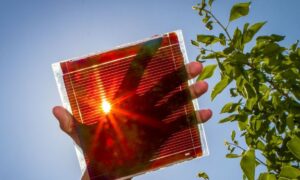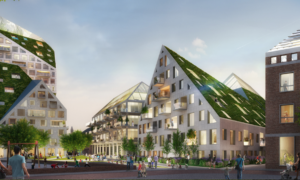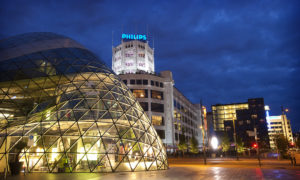To quote Ulysses Everett McGill, “Damn, we’re in a tight spot!” Coronavirus variant COVID-19 has swept through Europe just as it swept through China and is sweeping through the United States. The global economy is at a standstill, with the largest auto manufacturer such as Volkswagen suspending production. Eindhoven is not immune, so to speak.
The coronavirus first took hold in the Brabant region a few weeks ago, with the first recorded case 27 February in Tilburg. Less than three weeks later, High Tech Campus Eindhoven, the heart of Eindhoven’s innovation ecosystem, is a ghost town as everyone works from home per the recommendations of Dutch leaders including Prime Minister Mark Rutte.
Big tech companies including ASML are changing schedules to reduce the number of interpersonal interactions. But one big show will go on.
FasTrackathon
HighTechXL is going digital!
We’re partners with Eindhoven’s deep-tech venture builder, so we have the details, which are evolving.
As with the previous FasTrackathons, this is a reverse-hackathon. HighTechXL provides the technology from research labs such as CERN, European Space Agency and from commercial R&D labs. You provide the talent and fast-track the tech to the market.
Here’s how the 25 March event will work:
The first two FasTrackathon brought together dozens of techies and aspiring entrepreneurs and produced eight businesses including stars such as Incooling, Dynaxion, Aircision and Carbyon.
Those startups already are getting traction including joint ventures with some of the largest tech companies in the world including Gigabyte, and, above all, serious investment and funding.
With COVID-19, we’ll all be working together virtually using online environments while staying in our safe places.
The third FasTrackathon is an online event. The date – 25 March – is the same, as are the hours for the main activities – 9 a.m. to 1 p.m.
However, we’ve extended collaboration time for teams as they may need extra time to work with team members online. Some participants may also need to conduct work conference call or home-school children.
So, we built in extra time. Teams can further collaborate from 1 p.m. to 4 p.m. to prepare their pitches, which will take place from 4 p.m. to 5 p.m.
The digital version will basically be the same as our first two analog events, except, well, you won’t need Post-It notes.
FasTrackathon will start with an introduction/greeting from HighTechXL CEO Guus Frericks. Then everyone will divide into technology groups for technology presentations by technology “owners,” the inventors and other people responsible for connecting specific technologies with participants most interested in working with them.
Depending on the total number of participants per technology, groups will divide into sub-teams and begin generating ideas for application areas and business opportunities to take the tech to market.
Before we get into the details, you can still register for the event here.
At the upcoming FasTrackaton, HighTechXL will debut new technology from research centers including:
InnoFlex (proprietary technology from Kevin Lagarde)
This technology is a superior mass production system for high quality, flexible thin film nano materials, including flexible solar panels, (OLED) displays and other flexible electronics. The patented technology relies on a unique folding of the flexible substrate which allows high quality printing of semiconductor structures. InnoFlex technology can be applied to the production of all kinds of flexible thin film electronics, with the photovoltaics sector offering the best entry point due to the demand, environmental impact and maturity of the technology.
Kevin Lagarde, the tech owner inventor, will participate.
GIMOD (Technical University of Delft and SCALE Nanotech)
Graphene Interferometric MOdulator Display, or GIMOD for short. GIMOD is a reflective-type display, like e-paper. There is great contrast in bright environments, which means it uses less energy than standard smartphones or VR visors. Envision an ultra-thin, flexible electronic screen with a resolution of 12K, 50-percent greater than the highest resolution screen on the market. This makes that VR experience even more “real.” GIMOD technology can also be combined with many other smart devices such as phones, watches, glasses, contact lenses and helmets.
GIMOD’s inventor and Google Scholar Santiago Cartamil-Bueno will be participating.
inPhocal (inspired by technology developed at CERN)
inPhocal’s technology features a unique laser beam with a small central spot surrounded by rings. Because of its structure, it can travel without the central spot changing in size. Standard laser beams lose their focus quickly – sometimes within 1 mm – but this laser beam can maintain a focused spot at a distance 400 times longer than conventional systems.
Photonic Gyroscope (European Space Agency and Politecnico di Bari)
When you envision a gyroscope, you think of a spinning wheel inside a metal frame. Fast-forward to the 21st century, and you get a light-based gyroscope that can be implemented on a photonic chip. The photonic gyroscope can be used in high-precision control of aircraft, ships, and robots as well as medical aids and equipment such as biomechanical suits and MRIs.
Aqua Pacer (Philips)
Aqua Pacer technology monitors individual dehydration, which can cause issues such as headaches, issues with concentration and performance deterioration for athletes.
Aqua Pacer uses CMUT technology for direct bladder content measurement. The precise content of the bladder can act as a signal for a person to hydrate. The CMUT is worn as a patch on the abdomen and connected to a smart device. This device sends a signal to the app telling the person how much hydration is needed and when.
Nestegg Biotech
Nestegg Biotech B.V. has developed the Obruza Cell System as an answer to the rising costs and high standards associated with today’s laboratories. This integrated system can automate 90-percent of the work flow in cell culture applications. The system is designed to automate busy, repetitive lab tasks in sectors including drug development and discovery, mass spectroscopy bioreactors and organ-on-a-chip/microfluidics.
One of the most important strands in Eindhoven’s innovation DNA is creating new companies that will become the ASMLs and Philips of the future … big innovators that hire lots of people.
That’s the mandate for HighTechXL and the Eindhoven Startup Alliance … create, then nurture, the next wave of tech companies to ensure another generation of innovation.





























